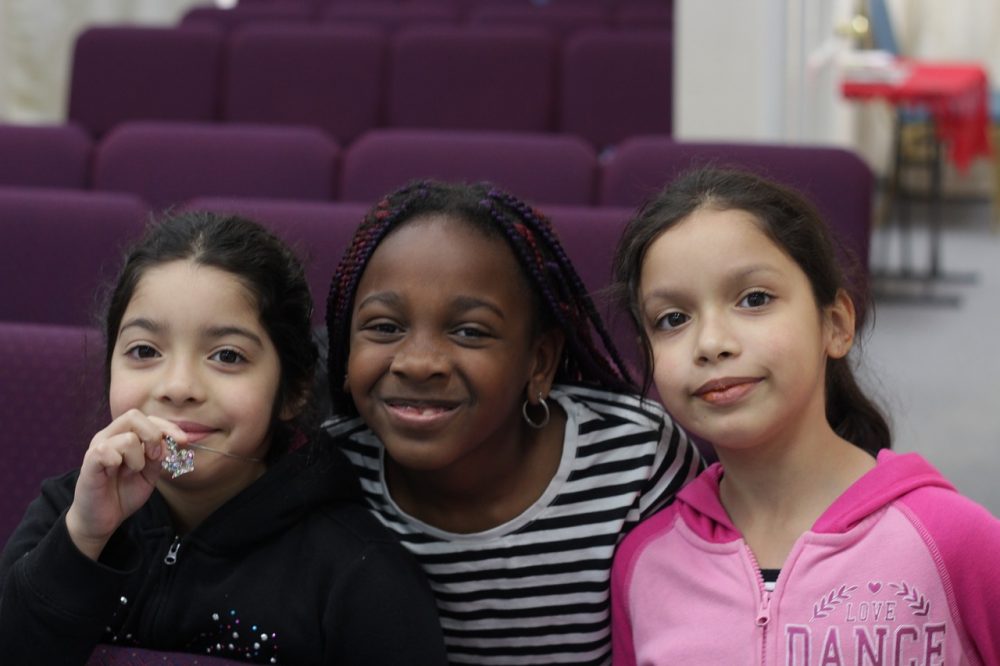You see that three-year-old who can’t sit still during the sermon? The one whose daddy had to take him out of the worship gathering three times last week because he was being disruptive? Yeah…that one.
Well, in 15 years he will be 18, graduating from high school and youth group. What if I told you that 18-year-old him can find any verse in the Bible in 8 seconds flat, tell you the author and theme of each book of the Bible, recite several long passages of Scripture, and discuss the many attributes of God at length? And he’s planning on teaching the middle school Sabbath school class. He regularly leads corporate prayer, and he knows every member of the congregation by name and greets most of them every week.
The 4-year-old girl that sits two rows in front of him? She’ll have all that Scripture stuff down pat, too. At 19, she’s already known as a prayer warrior. She’s also helped coordinate several outreach events that have brought a lot of new members into the church community. She has a busy schedule but is known for being incredibly trustworthy and diligent.
And the 6-year-old boy across the aisle? At 21, he’s coordinating the congregation’s ministry to shut-ins while training to become a pastor. He’s reserved but has a knack for making everyone around him feel comfortable, which is important because many of his friends ask him questions about what God has to say about various life issues.
The really cool thing is that it isn’t just them. Their entire peer group knows the Bible backwards and forwards. It takes some of them a while to find their ministry niche, but when they do there is no doubt that God’s hand is with them.
This Vision Starts Now
The amazing thing is that this doesn’t have to be a mere dream. This vision can become a reality, but ONLY if your congregation defines the vision and becomes intentional about helping it to take shape.
Think about it. Really think about it. When the kids of your congregation graduate from high school, what are their church family’s hopes for them? What do you want them to be able to do? Say no to drugs and premarital sex? Keep coming to your congregation’s worship gatherings every week? Or have you set your expectations higher than this?
My hope and prayer for the children of my congregation is that by the time they are 18, they would all…
- Be known as young adults who love God and reflect His character in their relationships
- Be able to explain how individual passages of scripture fit within the greater context of scripture…and how to apply those passages to their lives
- Delight in fellowshipping with God and engage in practices that enable them to listen to and hear His voice and to walk in His power
- Either be seeking to understand His calling in their life as it pertains to both vocation and ministry or already be starting to walk in it
- Be able to articulate a Biblical worldview and be able to make personal decisions and judgments that are aligned with this worldview
- Be able to effectively communicate and invite others to celebrate the good news of Jesus and His Kingdom
Yes, these are things that we as adults often struggle with, but shouldn’t we want to train our children so that they might struggle with them significantly less than we do?
Then we need a plan.
Scope It Out
When hunters identify a target, they look down the scope of their gun to make sure that their aim is going to be as accurate as possible.
Likewise, when we talk about the long-range teaching of students, we talk about the scope – the aim or purpose, the end result – of this instruction. Scope also refers to the extent or the range of the view. We have a specific goal in mind, but that purpose may encompass a lot of target points. When we define the scope of instruction, we identify all of those target points within our view.
This means turning those broad goals you come up with into a lot of measurable objectives. Let’s take the first goal I mentioned:
G1: Be known as loving God and reflecting His character
This goal has a lot of components. Here are some possible objectives:
Upon graduating from the children’s education program (PreK-12), students will be able to…
- List and describe attributes of God’s character
- Give examples of what it looks like for humans to embody these virtues
- Define these character traits in human terms
- Be able to give examples of instances where they have embodied these virtues and instances where they have failed to embody these virtues
- Complete a self-evaluation regarding their own character
- Identify areas of personal character strength and personal character weakness
- Work with a mentor to identify a plan to grow in areas of personal character weakness
- List biblical figures who loved God, how they demonstrated this love, and why God approved of their love
- Cite and describe biblical teachings regarding the demonstration of love
Let’s take a stab at scoping out another goal:
G3: Delight in fellowshipping with God and engage in practices that enable them to listen to and hear His voice and to walk in His power
Here are some possible objectives:
Upon graduating from the children’s education program (PreK-12), students will be able to…
- Be quiet before the Lord for 30 minutes without becoming distracted or falling asleep
- Be in prayer/conversation with the Lord for 30 minutes without becoming distracted or falling asleep
- Pray memorized Scripture (out loud) over individuals seeking prayer
- Meditate on memorized Scripture for 15 minutes without becoming distracted or falling asleep
- List and explain from Scripture how the Holy Spirit enables us to commune with God
- List and cite examples of how God communicated with people in Scripture
- Describes examples of fasting in Scripture and how fasting can be utilized today to draw closer to God
- Describe the need for and significance of confession in coming before God
- Give a biblical definition of worship and cite 5 ways that they engage in worship on a daily basis
- Identify 20 names of God, give examples of how He made Himself known these ways in Scripture, and how He has made Himself known in the student’s life
- Identify 5 causes close to God’s heart and engage in group prayer for these causes
- Be able to “pray on” the Armor of God
Remember, these are just a handful of the objectives that could be used to help flesh out some of these goals. The important thing is that there is a direct correlation between the objective and the overall goal…and that the objective be observable.
Creating a Sequence
The above objectives reflect what we might want our 18-year-old church members to be able to demonstrate. Not our 17-year-olds, but our 18-year-olds. Does that mean that 16-year-olds are off the hook and we are just going to spring all of these things on them when they turn 17? No…it means they should be getting close. What about the 13-year-olds? Are they just being introduced to these concepts, too? No, they are also getting close! And what about those 6-year-olds…
This is where the planning really gets fun…at least in my opinion. We take the scope, and we break the objectives down into a logical progression of steps aka, a sequence. In education, you’ll often see the phrase “scope and sequence.” This phrase simply refers to a long-term plan to cover everything in a curriculum’s scope.
Let’s take Goal 3, Objective 1: Be quiet before the Lord for 30 minutes without becoming distracted or falling asleep.
If this objective is sprung on an average 18-year-old who hasn’t had practice sitting before the Lord, they will become distracted within 30 seconds and possibly fall asleep within 5 minutes. Confession: I know this from personal experience.
Instead, we break this objective into stages. Let’s say that your congregation groups children and youth into five ages: toddler/pre-k, Grades K-2, Grades 3-5, Grades 6-8, Grades 9-12.
The objectives written in the grid in each column reflect what students should be able to do upon graduating from one age group to the next.
| Scope Goal/objective | Toddler /PreK | Grades K-2 | Grades 3-5 | Grades 6-8 | Grades 9-12 |
| G3: Obj 1 | Be quiet before the Lord for 30 seconds without becoming distracted or falling asleep. | Be quiet before the Lord for 2 minutes without becoming distracted or falling asleep. | Be quiet before the Lord for 5 minutes without becoming distracted or falling asleep. | Be quiet before the Lord for 10 minutes without becoming distracted or falling asleep. | Be quiet before the Lord for 30 minutes without becoming distracted or falling asleep. |
Yes…you read this correctly. If we want to set our 3-year-olds up for success when they are 18 years old, we can start by giving each of those little ones a Bible and setting the timer to sit quietly before the Lord for 30 seconds without becoming distracted and falling asleep. And trust me, at this age falling asleep will not be the issue. It is also important to note that we won’t start out setting the timer for 30 seconds. We would start out setting it for 5 seconds and increase the time weekly. This same principle would apply to every age group. High school students would start off training at 10 minutes and gradually increase to 30 minutes.
Here’s how Goal 3, Objective 3 might look:
| Scope Goal/objective | Toddler /PreK | Grades K-2 | Grades 3-5 | Grades 6-8 | Grades 9-12 |
| G3: Obj 3 | Lay hands on classmates (as a group) and repeat teacher-led prayers based on the Fruit of the Spirit and the Armor of God. | Able to recite Galatians 5:22-25 and Eph 6:10-17 by memory. Lay hands on classmates, and as a group, pray the Fruit of the Spirit and the Armor of God over one another. | Able to recite Galatians 5:22-25 and Eph 6:10-17 and other 3 selected passages by memory. Lay hands on classmates, and take turns praying these scriptures over one another | Able to recite 15 selected passages by memory. Lay hands on classmates in small and large groups and take turns praying selected scriptures over one another as those scriptures fit the situation. | Able to recite 25 selected passages by memory. Share prayer requests with other another and lay hands on and pray for one another individually and in groups using scripture as the Spirit leads. |
One of the hidden blessings here is that it is such a powerful thing to watch 3-year-olds pray for one another! They love to take turns getting in the middle of the prayer circle, and they love to put their hands on the shoulders of the person in the middle of the circle and pray for them. It is a truly beautiful sight and sound.
In the case of every single end objective, there is a “baby step,” a “seed,” that can be incorporated into the instruction for even the youngest children.
Beyond the Church Building
The goals and objectives expressed above are not intended to be carried out as the sole responsibility of a congregation’s Sabbath School program or even for them all to be taught within the context of Sabbath School. If an entire generation is to be trained to become mature adult Christians, they will need the encouragement and prayer support of their entire congregation.
If an entire generation is to be trained to become mature adult Christians, they will need the encouragement and prayer support of their entire congregation. - Amber Riggs Click To TweetBelieving parents and parent figures, in particular, will need to come together to embrace this vision and be equipped to lovingly call and coach their children to this vision in a manner that reflects Christ’s character. After all, if we speak and teach God’s Truths in the tongues of men or of angels, but have not love, we are nothing but resounding gongs and clanging cymbals. In addition to this, if these goals are to be realized, parents must be equipped to pray for and do spiritual warfare on behalf of their children.
Parents must be equipped to pray for & do spiritual warfare on behalf of their children. - Amber Riggs Click To TweetIt is the hope and prayer that as the children demonstrate maturity, their friends and other children will become part of the church family. While these children will initially be “behind,” they will be entering into a culture of supportive learning. That is, it is easier to come alongside a handful of children to help them catch up than it is to accelerate an entire group of students. The culture of the congregation should be one where students come alongside one another and parents come alongside their children’s friends to foster an environment of genuine discipleship.
Back to the Future
Does your congregation currently struggle with finding enough individuals who can effectively implement all that you believe God wants for your congregation?
What does God believe is possible for the vision of your congregation? Ask Him! Then ask your pastor and the congregational leadership team. Ask the parents of your congregation what their discipleship goals are. Most of all, ask God to show you all His vision, plan, and strategy for raising up the children of your congregation to be in alignment with His heart for your congregation.
What does God believe is possible for the vision of your congregation? Ask Him! - Amber Riggs Click To TweetIt is my conviction that congregations are no more than 15 years away from being vibrant, thriving congregations who are effective at making the Kingdom of God a reality in their communities. It is never too early or too late to start. Where are your 10-year-olds at right now? What about your 15-year-olds? What about your 45-year-olds? Define your congregation’s goals and objectives and then meet each age group where they are. Continue walking alongside one another in baby steps until a vibrant discipleship is part of the culture of your congregation.
Do you desire your local congregation to embrace this vision for their future? To become better equipped for bringing this vision into reality, here are some excellent Artios resources for you:
- Enroll in Artios Christian College’s CHE 301 Christian Education course
- Read about why you are a leader here
- Why Sabbath is Meant to Be Simple - July 13, 2020
- A God- Shaped Goal - June 5, 2020
- Creation Waits - April 9, 2020






